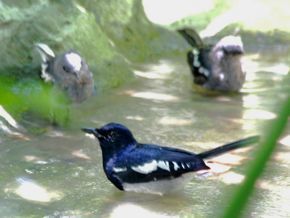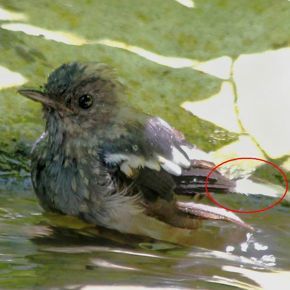“It was a hot and sunny mid-day at the Singapore Botanical Gardens. Walking under the shady trees along a footpath that was lined with tall bushes on one side, I was curious and looked beyond the plants through the gaps in the vegetation. Lo and behold! There was a small clearing that was well hidden from normal view. Standing quietly in a shallow stream that was behind the bushes were three Oriental Magpie Robins (Copsychus saularis). An adult male and its two juveniles were obviously preparing to bathe (left).
“As the two juveniles watched, the adult commenced by dipping and submerging its head into the water. Soon, the water was agitated by the quick motion of the bird’s head bobbing up and down and twisting left and right. This was followed by a few vigorous twists of its body in the water. Feathers were ruffled and wings were flapped to shake away the water. After a few rounds, it left the water to perch on a rock to dry itself. Clearly, it was good idea to cool down by taking a bath during hot weather and this adult was perhaps mentoring the juveniles to indulge in such activity for cooling down. Water may also have entered its throat for a much needed thirst quencher.
“It did not take long for the juveniles to do the same and bathe in the slow moving stream (above). From the time captured in the images, the entire bathing episode for this family of robins lasted 1 minute and 23 seconds before flying out of view.
“It may be of interest to note that one of the juveniles’ tail feathers seemed to be completely white and without any black (above right). This was not noticed in the field when I was too engrossed in capturing the pictures. It was discovered only while reviewing the images. The normal colour of the long tail feathers is black on the topside and white on the underside. Usually, only the blacks are visible on the topside of the tail. The white tail feathers are underneath and covered by the black tail feathers. The whites, which may be visible at times along the outer sides of the tail, are only more obvious and prominent when the tail is fanned.”
Kwong Wai Chong
Singapore
24th September 2010












One Response